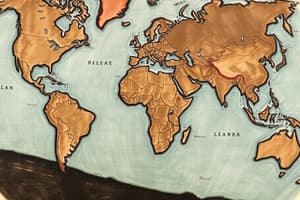Podcast
Questions and Answers
Considering the complexities of global migration patterns, which scenario BEST exemplifies the interplay between emigration and immigration in shaping a country's demographics?
Considering the complexities of global migration patterns, which scenario BEST exemplifies the interplay between emigration and immigration in shaping a country's demographics?
- A country's net migration rate remains stable as the number of immigrants precisely matches the number of emigrants, resulting in a stagnation of population growth and cultural diversity.
- A country witnesses a simultaneous increase in both emigration and immigration, with the inflow of skilled workers offsetting the outflow of unskilled laborers causing a balanced demographic shift.
- A country experiences a surge in emigration due to political instability, leading to a rapid decline in its overall population and workforce, with minimal impact on social services.
- A country attracts a large number of immigrants seeking economic opportunities while simultaneously experiencing emigration of its highly educated citizens, leading to a potential brain drain and increased demand for social services. (correct)
Given the various forms of migration, which of the following scenarios BEST illustrates the complexities of distinguishing between voluntary and involuntary migration?
Given the various forms of migration, which of the following scenarios BEST illustrates the complexities of distinguishing between voluntary and involuntary migration?
- A family relocating to another country to pursue better economic prospects.
- A community displaced by a natural disaster being resettled in a different region by the government.
- An individual leaving their home country due to a well-founded fear of persecution but also seeking better economic opportunities elsewhere. (correct)
- A group of people moving from a rural area to an urban center in search of employment.
In what way does the distinction between rural-urban and urban-rural migration MOST significantly impact regional development and resource allocation strategies?
In what way does the distinction between rural-urban and urban-rural migration MOST significantly impact regional development and resource allocation strategies?
- Urban-rural migration creates a uniform distribution of population density across regions, which simplifies resource allocation decisions.
- Rural-urban migration leads to decreased demand for public transportation in urban areas, which causes a shift in infrastructure investment.
- Rural-urban migration strains urban infrastructure and services, requiring investments, while urban-rural migration can revitalize rural economies if managed effectively. (correct)
- Urban-rural migration results in reduced strain on urban housing markets, prompting a decrease in residential construction.
If a country has a high rate of emigration of skilled workers and a low rate of immigration, what is the MOST likely long-term economic consequence?
If a country has a high rate of emigration of skilled workers and a low rate of immigration, what is the MOST likely long-term economic consequence?
Given the broad definition of migration, how can the concept of 'environmental changes' as a driver of migration be MOST accurately interpreted in the context of long-term population movements?
Given the broad definition of migration, how can the concept of 'environmental changes' as a driver of migration be MOST accurately interpreted in the context of long-term population movements?
Considering the variables impacting migration, which situation exemplifies the MOST complex interplay of economic, environmental, and political factors influencing a person's decision to migrate?
Considering the variables impacting migration, which situation exemplifies the MOST complex interplay of economic, environmental, and political factors influencing a person's decision to migrate?
If two countries have the same number of immigrants, but Country A has a significantly higher number of emigrants compared to Country B, what can be concluded about their net migration?
If two countries have the same number of immigrants, but Country A has a significantly higher number of emigrants compared to Country B, what can be concluded about their net migration?
Considering urban-rural migration, which outcome would MOST effectively indicate successful integration of urban migrants into rural communities?
Considering urban-rural migration, which outcome would MOST effectively indicate successful integration of urban migrants into rural communities?
How does 'regional migration' WITHIN a country MOST profoundly affect the distribution of economic opportunities and social resources at a national level?
How does 'regional migration' WITHIN a country MOST profoundly affect the distribution of economic opportunities and social resources at a national level?
In what scenario does the 'migration' definition MOST challenge traditional understandings of population movement and settlement?
In what scenario does the 'migration' definition MOST challenge traditional understandings of population movement and settlement?
How does the phenomenon of 'brain drain,' resulting from international migration, MOST significantly impact developing countries?
How does the phenomenon of 'brain drain,' resulting from international migration, MOST significantly impact developing countries?
Which of the following scenarios BEST illustrates the potential long-term societal impact of 'involuntary migration' on both the displaced population and the host community?
Which of the following scenarios BEST illustrates the potential long-term societal impact of 'involuntary migration' on both the displaced population and the host community?
In what way can the accurate measurement of 'net migration' rates MOST effectively inform policy decisions related to immigration and population management?
In what way can the accurate measurement of 'net migration' rates MOST effectively inform policy decisions related to immigration and population management?
When considering responses to large-scale migration events, which strategy would MOST effectively address the long-term needs of both the migrants and the host communities?
When considering responses to large-scale migration events, which strategy would MOST effectively address the long-term needs of both the migrants and the host communities?
Given the interplay of factors driving migration, which of the following scenarios presents the MOST significant challenge for policymakers aiming to manage migration flows effectively?
Given the interplay of factors driving migration, which of the following scenarios presents the MOST significant challenge for policymakers aiming to manage migration flows effectively?
Considering the various forms of migration, in which scenario is it MOST difficult to predict the long-term impact on both the origin and destination regions?
Considering the various forms of migration, in which scenario is it MOST difficult to predict the long-term impact on both the origin and destination regions?
In which scenario would the 'voluntary migration' process MOST likely transform into an 'involuntary migration' situation?
In which scenario would the 'voluntary migration' process MOST likely transform into an 'involuntary migration' situation?
What is the MOST significant difference between regional migration and international migration?
What is the MOST significant difference between regional migration and international migration?
Which circumstance would MOST substantially complicate the calculation and interpretation of net migration rates for a particular country?
Which circumstance would MOST substantially complicate the calculation and interpretation of net migration rates for a particular country?
When examining the long-term consequences of migration on a given country, what factor would MOST significantly determine whether migration has a positive or negative impact?
When examining the long-term consequences of migration on a given country, what factor would MOST significantly determine whether migration has a positive or negative impact?
Flashcards
Migration
Migration
Movement of people from one place to another, often due to environmental or economic factors.
Immigration
Immigration
Coming to live permanently in a foreign country.
Emigration
Emigration
Leaving one's country to settle permanently in another.
Net Migration
Net Migration
Signup and view all the flashcards
Rural to Urban Migration
Rural to Urban Migration
Signup and view all the flashcards
Urban to Rural Migration
Urban to Rural Migration
Signup and view all the flashcards
Voluntary Migration
Voluntary Migration
Signup and view all the flashcards
Involuntary Migration
Involuntary Migration
Signup and view all the flashcards
Regional Migration
Regional Migration
Signup and view all the flashcards
International Migration
International Migration
Signup and view all the flashcards
Study Notes
- Migration is the movement of individuals or groups from one place to another.
- Migration is often driven by environmental changes, economic opportunities, or other reasons.
- Immigration is the action of coming to live permanently in a foreign country.
- Emigration is the act of leaving one's own country to settle permanently in another country.
- Net Migration is the difference between the number of immigrants and the number of emigrants.
- Rural to urban migration happens when people move either temporarily or permanently from a rural area to an urban city.
- Urban to rural migration is when people move away from urban areas to rural regions because of problems of rapid urbanization like pollution, traffic, and bad housing.
- Voluntary migration occurs when someone chooses to leave their home.
- Involuntary migration involves any foreign-born people who have migrated.
- Regional migration refers to the movement of individuals from one region to another within a country.
- International Migration represents the movement of people across international borders for the purpose of settlement.
Studying That Suits You
Use AI to generate personalized quizzes and flashcards to suit your learning preferences.




